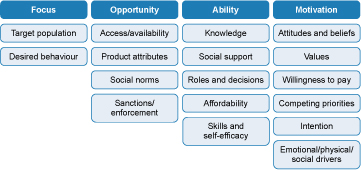Use 'Print preview' to check the number of pages and printer settings.
Print functionality varies between browsers.
Printable page generated Thursday, 25 April 2024, 6:18 PM
Study Session 8 Assessing Behaviour
Introduction
In this study session you will learn about the purpose of assessing behaviour and how to use a framework approach to identify and understand the causes of a particular behaviour for different participant groups. You will also learn how to identify the context of a particular behaviour and the role of gender in influencing behaviour.
Learning Outcomes for Study Session 8
When you have studied this session, you should be able to:
8.1 Define and use all of the key words marked in bold. (SAQ 8.1)
8.2 Identify target groups for a behaviour change intervention using participant analysis. (SAQ 8.2)
8.3 Analyse and explain behaviours in the context of hygiene and sanitation using a FOAM framework. (SAQs 8.3 and 8.4)
8.4 Understand the difference between sex and gender characteristics, and summarise the role of gender in hygiene and sanitation behaviour. (SAQs 8.4 and 8.5)
8.1 Assessing behaviour in the context of hygiene and sanitation
Health behaviour is defined as any action that is related to disease prevention, health maintenance, health improvement or the restoration of health. Health behaviour can be affected by many different personal attributes such as beliefs, expectations, status, income, motives, values, perceptions and personality characteristics including emotional states and traits.
As a frontline WASH practitioner you may be tasked with promoting improved hygiene and sanitation related health behaviours in your community. Improving behaviours means getting people to change their existing behaviour – not always an easy activity!
Think of a time when you have tried to get one or more people to change their behaviour, either at home or in your job. You should be able to say:
- who needed to make what change (and who needed to support them)
- what the key factors were in motivating and/or holding back these individuals/groups
- what you did to influence those factors and bring about the change.
Identifying these key components to your situation is essentially applying a framework that helps you to understand and consider all the factors involved in the process. In this case, these three points could be grouped as follows:
| In order to help … | I focused on … | through … |
| … the target population to achieve desired behaviour | … the key factors | … influencing activities. |
When you want to plan a behaviour change, using a framework approach like this is a good way to make sure you are capturing all the important issues.
8.2 Analysing and explaining behaviours using a FOAM framework
A number of frameworks have been developed specifically for use in the WASH sector. We are going to concentrate on a framework called FOAM, which stands for Focus, Opportunity, Ability and Motivation (Devine, 2009). The FOAM framework is shown in Figure 8.1. (Note that this version of FOAM is sometimes called SaniFOAM, when it has a particular focus on sanitation.) This is a comprehensive approach that expands on our simple framework above by asking us to think in more detail about the determinants affecting the behaviour that we want to change. Behavioural determinants are the reasons why people do or do not practise a given behaviour. Behavioural determinants can be internal (such as a belief about menstruation habits) or external (such as regulations against open defecation). The FOAM framework groups behavioural determinants under four headings.
In this framework:
- focus identifies the target group and the behaviour that needs to change
- opportunity includes questions around whether someone has the chance to change their behaviour
- ability looks at whether someone is capable of changing their behaviour
- motivation explores whether someone wants to change their behaviour.
Through these indicators, FOAM can be used to:
- define and prioritise interventions that aim to change behaviour
- analyse results of studies
- inform the design of new research and data gathering.
So how do we put it into action? In the rest of this session we will look at understanding Focus, Opportunity, Ability and Motivation in more detail and explore some tools that will help you gather the information you need to understand the current situation for a behaviour that you want to change.
8.2.1 Focus
You can see from Figure 8.1 that the first step is to identify your target population and the behaviour that you want to see changed.
The behaviour change could be driven by lots of different factors. In some cases it will be urgent, perhaps because of a disease outbreak linked to certain hygiene habits. In others it may be driven by the routine requirements of your role or perhaps a government programme to reach particular targets. You should always seek support and guidance from senior colleagues to ensure that your planned change is appropriate and review this decision once you have completed the FOAM framework and have a better understanding of all the determinants. You will spend more time thinking about desirable behaviours in Study Session 9.
The target population is simply the group that needs to make the change and this is up to you to define. For example a target population could be:
- male heads of households
- girls aged 10–16
- mothers
- rural households
- households of more than six people
- urban slum dwellers
- parents with a child under the age of three
- people living with HIV/AIDS.
Target populations can usually be divided into different levels according to their positions and influence on the desired outcome. We will use an example to illustrate these different levels. Imagine that you have been tasked with promoting handwashing with soap among young children in schools in your woreda. The children (Figure 8.2) will be your primary target population or group.

Associated with the primary target group are the people and community organisations that directly influence them through their own behaviour and actions (see Figures 8.3 and 8.4). This is your secondary target group and could include parents, teachers, or members of parent teacher association (PTAs).
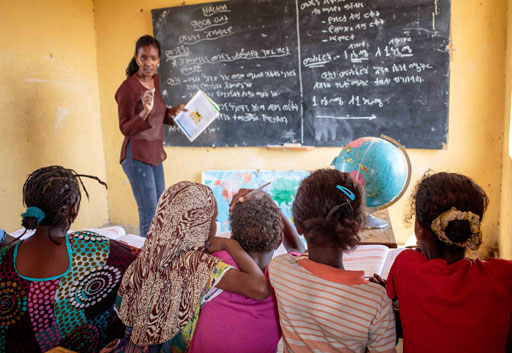
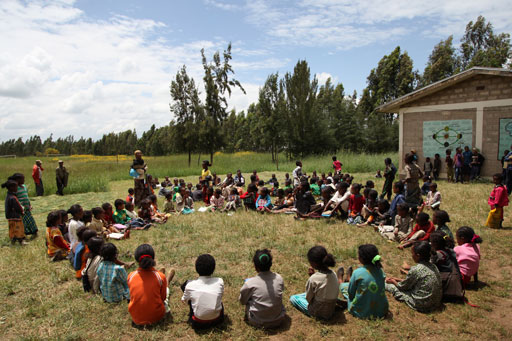
Beyond this is the tertiary group. Figure 8.5 shows the relationship between the primary, secondary and tertiary groups. The tertiary target group, in the outermost ring, is composed of people who indirectly help or hinder the primary and secondary groups. The actions of tertiary participants reflect the broader social, cultural and policy factors that create an enabling environment for behaviour change. In our example these may include kebele or woreda administrators, religious leaders, and representatives of women’s groups and youth associations.

This process of analysing the different target groups is called a participant analysis. When you have completed it, you will have identified the primary, secondary and tertiary target populations for your planned handwashing promotion in schools. You will also have filled the first column of your FOAM framework. Note that depending on the scale of the intervention there may sometimes be only primary, or only primary and secondary, groups.
Imagine you are planning to promote handwashing with soap among mothers of children under the age of five in your woreda. Draw a diagram like the one in Figure 8.5 and identify who might be the main primary, secondary and tertiary target populations.
Your answer should look similar to Figure 8.6.
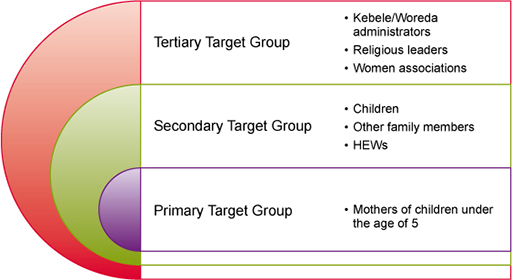 Figure 8.6 Suggested answer showing the main primary, secondary and tertiary target populations.
Figure 8.6 Suggested answer showing the main primary, secondary and tertiary target populations.
8.2.2 Opportunity determinants
The FOAM framework (Figure 8.1) provides four subheadings for the behavioural determinants relating to whether someone has the chance to engage in the desired behaviour.
Access and availability
These are external factors that will influence the opportunity for change. For example, if you want your target population to use latrines for defecation, then some of the access and availability determinants might be as follows:
- If a man is working in an area where there are no latrines then he may defecate in the open, even if he used a latrine at home.
- If there are no materials available to build latrines or no skilled builders in the area, then people will not have access to a latrine.
Product attributes
It’s not sufficient for there just to be access and availability if the products or services are not appropriate. Following on from the examples above:
- If there is a latrine available near the man’s workplace but it is poorly maintained and unpleasant, he may not use it.
- If there are materials available but they are poor quality, or there is a skilled builder who has a reputation for dishonesty, latrines may still not be built.
These examples of behavioural determinants are deterrents to the desired behaviour, but it’s important to note that factors under these headings can also be facilitators – things that encourage and support the desired change. (In Study Session 7, facilitators were defined as people who guide and support meetings. The word can also be applied more broadly to anything that helps or supports an outcome.)
Social norms
Our behaviour is strongly influenced by the behaviour of similar people around us, in other words by social norms. People may follow examples of both good and bad behaviour and you need to consider both in your framework. For example you may note that a worker at a building site opts to use a public latrine rather than defecate in the open because he has seen his colleague using it. You might also note that people don’t clean this latrine after use because each person observes that the user before them hasn’t done so.
Sanctions and enforcement
Sanctions are penalties that may be imposed on people who behave badly. For example, people who leave their rubbish by the roadside may have to pay a fine. You should note whether any sanctions like this influence behaviour and how firmly they are enforced.
8.2.3 Ability determinants
The FOAM framework provides five subheadings for the behavioural determinants relating to whether someone is capable of engaging in the desired behaviour.
Knowledge
Knowledge can mean understanding or the lack of it. For example:
- A woman knows she should store water in a vessel with a secure lid.
- A man is not aware that he should wash his hands after using the latrine.
- An urban dweller knows which company will empty their septic tank.
Knowledge about the desired behaviour is essential for your target population, but knowledge alone is rarely sufficient to bring about a change in action.
Skills
The special knowledge of how to do something in an effective way is a skill. For example:
- A caretaker knows how to properly clean a toilet.
- A technician knows how to repair a hand pump.
- A young woman knows how to manage menstruation hygienically and with dignity.
Again, remember that each behaviour determinant can be a facilitator or a deterrent. Each of the examples above are facilitators, but if you were to swap ‘knows’ for ‘doesn’t know’, they become examples of deterrents.
Consider the two situations below. Which relates to knowledge and which to skills?
- a.A mother is unaware that she can use sterilising tablets to make river water safe for drinking.
- b.A mother doesn’t know how to sterilise water to make it safe for drinking.
The first situation relates to knowledge because she is unaware or ‘doesn’t know’ something. The second relates to skills because she ‘doesn’t know how to do’ something.
Social support
Social support is the care that individuals and groups give to each other. This sort of care may be physical, emotional or in the form of information. Examples could include helping a disabled family member to wash themselves, providing emotional support for a young girl as she begins menstruating or telling a new neighbour where they can access clean water.
Roles and decisions
Within any behaviour change plan there will be a number of people who have influential decisions to make. For example, if you are asking households to adopt a certain practice (such as sweeping floors daily), then the roles may include anyone in the household who might take a turn in the activity, and decisions could include the purchase of a new broom.
Affordability
People may want to do something, or feel they should, but are not able to afford to pay for it. Saving money can be a powerful influencer. There are long-term economic benefits from many WASH practices, generally from improved health, but these are difficult to relate to individual behaviour.
It is also worth noting that affordability may be different from willingness to pay – for example, if a woman can afford to buy sanitary goods but knows that her friend gets them for free from a health centre, she might not be willing to pay. Affordability is an ability determinant, but willingness is a motivation. We’ll look more at this in the next section.
8.2.4 Motivation determinants
The FOAM framework provides six subheadings for the behavioural determinants relating to whether someone wants to engage in the desired behaviour.
Attitudes and beliefs
Beliefs are ideas that people hold to be true. Attitudes are shown in the way people treat others, express themselves or approach a situation. People are often unaware of their attitudes and beliefs. Regardless of whether a person’s beliefs are factually correct or not, they can be a powerful determinant in their understanding and perception of WASH behaviours. For example, some people believe that children’s faeces are not harmful but, in fact, they may pose a greater health risk than adult faeces because diarrhoea and parasitic worm infections are more common in young children (Brown et al, 2013). Assessing attitudes and beliefs can be difficult, but should not be underestimated in your FOAM framework.
Values
Values are closely related to beliefs and represent the code of conduct that a group or community choose to act by. For example, if modernity and progress are values that a community aspires to, then it will be more likely to adopt behaviour that is seen as consistent with these standards.
Emotional, social and physical drivers
Drivers are strong feelings that drive us or lead us to behave a certain way. For example, safety, comfort, privacy, disgust, status, pride, shame, shyness, modesty and vanity could all be drivers of either positive or negative behaviour.
Competing priorities
We have already noted affordability as a determinant, but just because someone can afford something doesn’t necessarily mean they will prioritise it in their spending, particularly when a household has very little money. Understanding the way financial decisions are made within a family and/or community can help you decide how and when to present the case for any expenditure that you are proposing.
Intention
In the context of the FOAM framework, intention describes the stage that your target population is at in its decision-making process and helps you to plan your intervention accordingly. For example, if there has been a public-awareness campaign about handwashing and you know that people understand the value of it, then your intervention might be focused on the provision of facilities. Or if people had slipped back into lazy habits and stopped bothering to wash their hands, then you might plan a new campaign to remind them. If there has been no such campaign, then there is no existing intention and your intervention will need to take a different approach.
Willingness to pay
As previously noted, willingness to pay tells us how much an individual or group will consider paying for what feature or benefit. It is closely related to both affordability and competing priorities.
8.3 Gathering information using a situation analysis
Situation analysis is, simply, finding out about a situation so you understand it. In the context of health behaviour assessment, it is a tool that helps to identify the various behavioural determinants that are facilitating or preventing progress in improving health, including improved hygiene and sanitation. The information that you gather will help to fill the spaces in your FOAM framework and to identify what you will need to overcome in order to bring about the desired change.
Using a situation analysis, you can also identify what has already been done to address hygiene and sanitation problems, what results were obtained and lessons learned. For example, you might find that people are using a local latrine that is well maintained and pleasant to use, and this could provide a model for building or upgrading other latrines in your area (Figure 8.7). You may also be able to find out who the main influential people are and who it might be important to get involved. In addition to ensuring that a particular intervention is appropriate to the local context, a situation analysis will also help avoid duplication of efforts.
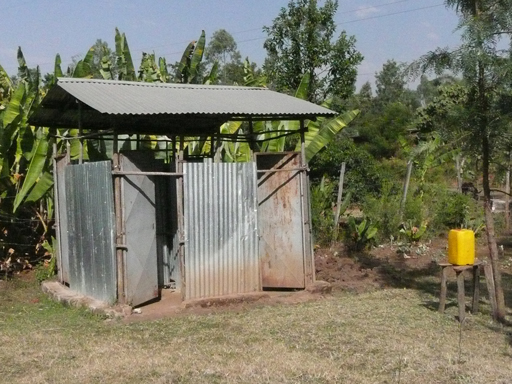
You need to take four steps to conduct behavioural situation analysis and organise the information you require. These are explained in Box 8.1.
Box 8.1 Steps of behavioural situation analysis for FOAM
Step 1: Identify what information is already available
When capturing a situation to populate the FOAM framework, you should use headings and subheadings (see Figure 8.1) to guide your thinking. It is important to start by listing all your available information and information sources. This could be knowledge that you have gained by observation, information gathered from colleagues, research and published data from journals or government documents, etc. Often, a lot more information is available than you might first expect.
Step 2: Identify what information is still required
When the available information is identified, it will become apparent where the gaps exist. List your unanswered questions and start to think about what you will need in order to gather the responses. Do note that this should be realistic – if you wait until the situation analysis is ‘perfect’, it will never be finalised.
Step 3: Collect the required information
You might want to carry out some in-depth interviews with members of your target population and/or the influencers around them or you might need to find out information such as prices, availability of a product or other external determinants. One very thorough method of understanding your target population or group better is to conduct a barrier analysis. Barrier analysis is a process for identifying the behavioural determinants that prevent or discourage change, i.e. the barriers to change. The process involves dividing a group into doers (who already practise the desired behaviour) and non-doers (who do not). You then interview all participants asking about their behaviour and the reasons for it, and then compare the results from the two groups to identify the key differences between them (Kittle, 2013).
Step 4: Complete the FOAM framework
When the situation analysis is complete you should have all the information that you need in your FOAM framework and should have captured a good understanding of the behaviour that you want to change.
Note that you may also come across the term ‘KAP analysis’, which stands for knowledge, attitudes and practice. This is another approach to finding out about a situation. It relies on collecting data from community members using surveys and questionnaires.
8.4 Role of gender in determining hygiene and sanitation behaviours
Gender plays a particularly significant role in hygiene and sanitation interventions. It is therefore important that we pay it particular attention in any behaviour analysis.
Some people may have difficulty in understanding exactly the difference between sex and gender. ‘Sex’ refers to a person’s biological status and is typically categorised as male or female. There are a number of indicators of biological sex, including sex chromosomes, internal reproductive organs and external genitalia. ‘Gender’ refers to the roles, behaviours and activities that a given society considers appropriate for males and females. In other words, ‘sex’ refers to biological differences between men and women and ‘gender’ refers to social and cultural differences.
While planning hygiene and sanitation promotion, you should consider that women, girls, men and boys all have different needs which must be identified and addressed. In hygiene and sanitation, gender makes a difference to:
- the way people are affected by a situation, especially access to latrines and hygiene facilities
- their attitudes, opinions and the way they see a situation
- whether they are more or less likely to support change
- their role, influence and ability to act.
Now read Case Study 8.1 and answer the question that follows.
Case Study 8.1 A teenage girl’s dilemma
Tirunesh is a teenage girl who started her periods about two years ago. She finds it embarrassing to go to school when she is having her period because her school does not have a separate latrine for girls. Moreover, her mother does not consider it particularly important to spend money on sanitary pads, preferring to keep her at home during her period to help look after her younger siblings. For these reasons, Tirunesh misses about five days of school every month, and now she is falling behind in her studies (Figure 8.8).
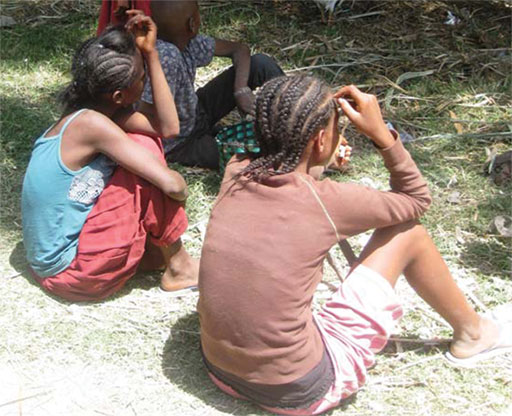
Explain why Tirunesh’s dilemma is a gender issue.
Girls all over the world have periods, but in the society in which Tirunesh lives, it is not considered important by her mother to provide her with sanitary pads in order that she should go to school every day, even during her period. This is a gender issue because it is her gender that makes it less likely that she will successfully complete her education.
Summary of Study Session 8
In Study Session 8, you have learned that:
- A framework approach helps to identify behavioural determinants that can facilitate or prevent progress in improving health including hygiene and sanitation.
- One such framework is FOAM, which identifies the target groups and people who can influence them as well as the opportunity, ability and motivation determinants of a behaviour.
- Tools that can be used to help build the content of a FOAM framework include participation, situation and barrier analysis.
- Gender has a strong influence on hygiene and sanitation-related behaviour.
Self-Assessment Questions (SAQs) for Study Session 8
Now that you have completed this study session, you can assess how well you have achieved its Learning Outcomes by answering these questions.
SAQ 8.1 (tests Learning Outcomes 8.1 and 8.3)
Match the following words to their correct definitions.
Using the following two lists, match each numbered item with the correct letter.
health behaviour
gender
situation analysis
sex
participant analysis
barrier analysis
a.any action that is related to disease prevention, health improvement or restoration of health
b.a means to determine the primary, secondary and tertiary target populations for a particular intervention
c.the roles, behaviours and activities that a given society considers appropriate for men and women
d.a person’s biological status as male or female
e.analysis that help you understand a situation
f.method for identifying the reasons why people do or do not practise a given behaviour
- 1 = a
- 2 = c
- 3 = e
- 4 = d
- 5 = b
- 6 = f
SAQ 8.2 (tests Learning Outcome 8.2)
An intervention is planned to provide free sanitary products to girls at local schools. A participant analysis has been conducted and has identified primary, secondary and tertiary target populations for the intervention. Classify the following according to where you think they were placed:
- teachers
- women/youth associations
- head teachers
- mothers
- other women in the household
- other women in the extended family and community
- girls of menstruating age
- health extension workers
- kebele/woreda administrators
- religious leaders.
Answer
Primary target population:
- Girls of menstruating age.
Secondary target population:
- Teachers.
- Head teachers.
- Mothers.
- Other women in the household.
Tertiary target population:
- Other women in the extended family and community.
- Health extension workers.
- Kebele/woreda administrators.
- Religious leaders.
SAQ 8.3a (tests Learning Outcome 8.3)
- a.According to the FOAM framework, the determinants of opportunity can be grouped under four subheadings:
- access and availability
- product attributes
- social norms
- sanctions and enforcement.
Match each of the following sentences to one of these determinant groups.
| Determinants of opportunity | Determinant subgroup |
| A toddler sees an older child washing their hands after using the latrine and copies this behaviour | |
| A family decides what sort of sanitary facility to build based on the single type of platform that is for sale in their local marketplace | |
| The mother in a household wants a different latrine because her friends have told her it is easy to clean | |
| The village community establishes a system for punishing anyone who contaminates their water supply |
Answer
a.
| Determinants of opportunity | Determinant subgroup |
| A toddler sees an older child washing their hands after using the latrine and copies this behaviour | social norm |
| A family decides what sort of sanitary facility to build based on the single type of platform that is for sale in their local marketplace | access and availability |
| A woman selects a new latrine for her household because her friends have told her it is easy to clean | product attributes |
| A village community establishes a system for punishing anyone who contaminates their water supply | sanctions and enforcement |
SAQ 8.3b (tests Learning Outcome 8.3)
- b.The determinants of ability are grouped under subheadings of:
- knowledge
- skills
- social support
- roles and decisions
- affordability.
Match each of the following sentences to one of these determinant groups.
| Determinants of ability | Determinant subgroup |
| A grandmother tells her daughter where she can dispose of her baby’s faeces | |
| A man starts encouraging his family to use soap for handwashing, because a local initiative is giving the soap away for free | |
| A girl hides her used sanitary pads because she doesn’t know where she should dispose of them | |
| A boy knows how to wash his hands effectively using soap and water | |
| A head teacher decides to implement changes at her school, meaning that all children have access to safe drinking water during the school day. |
Answer
b.
| Determinants of ability | Determinant subgroup |
| A grandmother tells her daughter where she can dispose of her baby’s faeces | social support |
| A man starts encouraging his family to use soap for handwashing, because a local initiative is giving the soap away for free | affordability |
| A girl hides her used sanitary pads because she doesn’t know where she should dispose of them | knowledge |
| A boy knows how to wash his hands effectively using soap and water | skills |
| A head teacher decides to implement changes at her school, meaning that all children have access to safe drinking water during the school day | roles and decisions |
SAQ 8.3c (tests Learning Outcome 8.3)
- c.The determinants of motivation are grouped under subheadings of:
- attitudes and belief
- values
- emotional, social and physical drivers
- competing priorities
- intention
- willingness to pay.
Match each of the following sentences to one of these determinant groups.
| Determinants of motivation | Determinant subgroup |
| During Ramadan, a family would rather save for celebration than spend money on sanitation | |
| A community would welcome the provision of an alternative to open defecation because they have a big problem with snakes | |
| A mother believes that her baby’s faeces are harmless and therefore do not need special measures for disposal | |
| The head of a household will pay for the materials needed to build a latrine but refuses to pay for the labour required | |
| A community believes in environmental sustainability | |
| A landlord agrees that he will upgrade the sanitation facilities in his properties |
Answer
c.
| Determinants of motivation | Determinant subgroup |
| During Ramadan, a family would rather save for celebration than spend money on sanitation | competing priorities |
| A community would welcome the provision of an alternative to open defecation because they have a big problem with snakes | emotional, social and physical drivers |
| A mother believes that her baby’s faeces are harmless and therefore do not need special measures for disposal | attitudes and beliefs |
| The head of a household will pay for the materials needed to build a latrine but refuses to pay for the labour required | willingness to pay |
| A community believes in environmental sustainability | values |
| A landlord agrees that he will upgrade the sanitation facilities in his properties | intention |
If you got any of these determinant questions wrong you should revisit the text to understand the differences. It is important to note that in every case there will be a number of complex issues and so you will be able to argue for other likely determinants coming into play if you start to think in more depth about each scenario. This is why it is important to spend time gathering all the available information in every case!
SAQ 8.4 (tests Learning Outcomes 8.3 and 8.4)
Assume that your primary target group in a handwashing promotion is mothers of children under the age of five years in your woreda.
- a.Identify one person who can directly influence these mothers.
- b.Identify one social norm that can negatively influence mothers’ handwashing behaviours.
- c.Identify one gender issue that affects mothers.
Answer
These are some examples you may have thought of:
- a.People who can directly influence mothers of children under the age of five years include HEWs, members of the Health Development Army, grandmothers and other relatives.
- b.Personal beliefs that may negatively influence mothers’ handwashing behaviour include believing that hands are clean unless they are visibly dirty. They may also believe that children’s faeces are not dangerous.
- c.Gender issues that may affect mothers are mostly related to their role in the home. Mothers are likely to be very busy with household chores. Husbands may not help mothers at home. Traditionally men do not get involved in household activities, such as food preparation, childcare and cleaning, so mothers often have to do these on their own.
SAQ 8.5 (tests Learning Outcome 8.4)
Which of the following are sex characteristics and which are gender characteristics?
- Women have breasts while men do not.
- Women do more household work than men.
- Women menstruate while men do not.
- Men are mostly responsible for earning money for the family.
- Many more men hold managerial positions than women.
- Men generally have larger bones than women.
- Women take most of the responsibility for caring the children at home.
- Men have facial hair while women do not.
Answer
Points 1, 3, 6 and 8 are sex characteristics:
- Women have breasts while men do not.
- Women menstruate while men do not.
- Men generally have larger bones than women.
- Men have facial hair while women do not.
Points 2, 4, 5, and 7 are gender characteristics:
- Women do more household work than men.
- Men are mostly responsible for earning money for the family.
- Many more men hold managerial positions than women.
- Women take most of the responsibility for caring the children at home.
